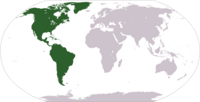Council of the Indies

The Council of the Indies (Spanish: Consejo de las Indias), officially the Royal and Supreme Council of the Indies (Spanish: Real y Supremo Consejo de las Indias, pronounced [reˈal i suˈpɾemo konˈsexo ðe las ˈindjas]), was the most important administrative organ of the Spanish Empire for the Americas and those territories it governed, such as the Spanish East Indies. The crown held absolute power over the Indies and the Council of the Indies was the administrative and advisory body for those overseas realms. It was established in 1524 by
History




The Council of the Indies was formally created on August 1, 1524.
Internecine fighting and political instability in
The Council of the Indies was usually headed by an ecclesiastic, but the councilors were generally non-clerics trained in law. In later years, nobles and royal favorites were in the ranks of councilors, as well as men who had experience in the high courts (Audiencias) of the Indies. A key example of such an experienced councilor was
Although initially the Council had responsibility for all aspects of the Indies, under Philip II the financial aspects of the empire were shifted to the Council on Finance in 1556-57, a source of conflict between the two councils, especially since Spanish America came to be the source of the empire's wealth. When the Holy Office of the Inquisition was established as an institution in Mexico and Lima in the 1570s, the Council of the Indies was removed from control. The head of the Supreme Council of the Inquisition, es:Juan de Ovando y Godoy became president of the Council of the Indies 1571-75. He was appalled by the ignorance of the Indies by those serving on the Council. He sought the creation of a general description of the territories, which was never completed, but the Relaciones geográficas were the result of that project.[10]
The height of the Council's power was in the sixteenth century. Its power declined and the quality of the councillors decreased. In the final years of the Habsburg dynasty, some appointments were sold or were accorded to people obviously unqualified, such as a nine-year-old boy, whose father had rendered services to the crown.[11]
With the ascension of the
The archives of the Council, the
See also
- Secretary of State (Ancient Regime in Spain)
- Spanish empire
- American Provincial Deputation of Spain
- Casa de Contratación
- Spanish colonization of the Americas
- for the Portuguese empire: Casa da Índia
References
- ^ "LAS INDIAS - Spanish Indies". Hubert Herald.
- ISBN 978-0-19-959726-0.
- ^ Fernando Cervantes, "Council of the Indies" in Encyclopedia of Mexico, vol. 1, p. 36163. Chicago: Fitzroy Dearborn 1997.
- ^ El Consejo Real de Castilla y la Ley
- ^ Gibson, Charles (1966). Spain in America. New York: Harper & Row. pp. 92.
- ^ Gibson, 94-95.
- ^ Recopilación de las leyes de Indias, Libro II, Título VI.
- ^ Gibson, 109-110, note 24.
- ^ Cervantes, "Council of the Indies" p. 361.
- ^ Cervantes, "Council of the Indies", p. 362.
- ^ Burkholder, Mark A. "Council of the Indies", vol. 2, p. 293. New York: Charles Scribner's Sons 1996.
- ^ Gibson, 167-168.
- ^ Burkholder, "Council of the Indies" p. 293.
- ^ Burkholder, "Council of the Indies" p. 293.
Further reading
- Burkholder, Mark A. Biographical Dictionary of Councilors of the Indies, 1717-1808. Westport: Greenwood Press, 1986. ISBN 0-313-24024-8
- Burkholder, Mark A. "Council of the Indies" in Encyclopedia of Latin American History and Culture, vol. 2, p. 293. New York: Charles Scribner's Sons 1996.
- Cervantes, Fernando. "Council of the Indies" in Encyclopedia of Mexico, vol. 1, pp. 361–3. Chicago: Fitzroy Dearborn 1997.
- Haring, Clarence H. The Spanish Empire in America. New York: Oxford University Press 1947.
- Merriman, R.G. The Rise of the Spanish Empire in the Old World and the New, 4 vols. New York: Cooper Square 1962.
- Parry, J.H. The Spanish Theory of Empire in the Sixteenth Century. Cambridge: Cambridge University Press 1940.
- Schäfer, Ernesto. El consejo real y supremo de las Indias. vol 1. Seville: M. Carmona 1935.
- Solórzano y Pereira, Juan de. Política Indiana. 2 vols. Mexico City: Secretaria de Programación y Presupuesto 1979.
- Zavala, Silvio. Las instituciones jurídicas en la conquista de América. 3rd. ed. Mexico City: Porrúa 1935.


